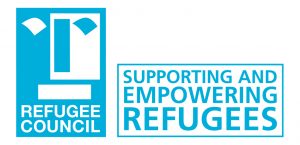
Frequently asked questions about using the Integration Star and how it can be used to support services and service users
Last October, Triangle launched the Integration Star, the Star to support refugees to integrate into life in the UK. The development of the Star has been a collaboration with the Refugee Council and the Star was piloted by the Refugee Council and their partners on the New Roots programme, in London and in Yorkshire & Humber.
In this blog, we bring together some of the frequently asked questions and draw on the expertise of Amilee Collins, National Project Worker at the Refugee Council, who shared her experience of using the Integration Star at our recent Webinar, Better conversations, Better outcomes. Amilee has 14 years experience resettling refugee families and her team offers a client-led holistic support service. She finds that the new Outcomes Star suits this approach.
What are the key benefits of using the Integration Star?
From Amilee’s perspective, one of the most important aspects of the Integration Star was that it is a visual tool that her clients could understand and engage unlike previous assessment frameworks used. The pictorial resources that accompany the Integration Star, support this engagement, even when communication is through an interpreter.
The visual snapshot that the Star provides, has also been extremely useful, as the visual communicates a client’s needs succinctly to other agencies, reducing the need for families to repeat everything to each agency involved in their support.
Another aspect of the Star that Amilee appreciates, is that the scales for each Outcome Area, based on a Journey of Change specific to the Integration Star, are clearly defined in the User guide. This helps the worker and client to identify where they are on the scale and helps them visualise next steps. Amilee feels this helps to promote some objectivity and parity between worker and client, as they use the Star together.
The Integration Star is structured around 8 Outcome areas and Amilee finds this helpful to break things down and she often completes the Star in more than one sitting. Amilee found that clients surprised themselves, as they worked around the Star; clients can become overwhelmed by the challenges they experience, but the Integration Star helped them see that they were progressing well in some areas, and this restored some confidence and self-belief and helped the client to get some perspective on the areas that were still difficult. Clients fed back that they found using the Integration Star useful and easy to understand.
Can you complete the Integration Star through an interpreter?
Amilee found that completing the Integration Star with a client via an interpreter was no different to doing any other work through an interpreter. Her top tip is to brief the interpreter beforehand and provide a Star chart and visual of the Journey of Change so that they can familiarise themselves with the concept of Outcomes Stars. Triangle has produced a leaflet for interpreters explaining the purpose of the Integration Star and explaining the Journey of Change. Amilee’s other piece of advice is to encourage the interpreter to speak in the first person; the Integration Star is about capturing the voice of the client, so she feels it is important to hear a client’s responses in the first person.
Is the Integration Star translated into other languages?
The Integration Star is not translated into other languages at the moment. The resources are very visual to support communication where the client might have limited English, or where an interpreter is being used.
Is the Integration Star a tool you use with individuals or families?
The Integration Star is designed to capture where an individual is on the Journey of Change scale and how they are navigating their new life in the UK, including supporting their children to settle. Amilee explained that she completes a Star for each adult in the family and gives them the opportunity to complete their Star one-to-one. This is really helpful to explore the different needs and strengths and perspectives of each individual.
Triangle has a range of other Stars that can be used with children and young people in the family to capture their voice.
What were the challenges of using the Star in lockdown?
Amilee was surprised how easy the Integration Star was to use remotely. Preparation is key, and Amilee always made sure, if she was going to do a Star remotely, that the client had access to Star resources. The visual of Journey of Change has been particularly helpful for clients to identify how they are feeling and then plot the relevant stage on their Star, so this usually meant printing and posting the Star Chart and Journey of Change to the client in advance of a phone or video call. Amilee used a range of platforms to talk to clients; Whatsapp, Zoom and Teams. The client usually used their phone screen for the call, so sending the client physical printed resources in advance, meant that the client didn’t have to look at the materials on the screens at the same time. Amilee would complete the Star during the call and sent a completed Star to the client.
Can the Integration Star be used with Asylum Seekers?
Triangle and the Refugee Council were open to the Integration Star working for Asylum seekers, but during the development process it became apparent that it would not be possible to structure clearly defined scales that could work well both for Refugees and for Asylum seekers, given the difference in eligibility for housing and benefits etc. so the scales, particularly Housing, Money and Education and Work relate options available to Refugees rather than Asylum Seekers.
****
The Integration Star is one of two new Stars which are designed to support organisations and services that work with service users who are refugees, asylum-seekers and need assistance in settling in their new home and navigating a new country. The Planning Star is the Outcomes Star for asylum-seeking children and may be more suitable for services working to support children. Both Stars have a strong foundation in supporting and empowering service users to best adjust and navigate the complexity of refugee and asylum-status. For more information please contact us.







